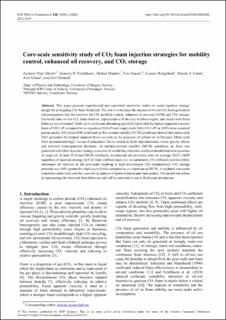| dc.contributor.author | Alcorn, Zachary Paul | |
| dc.contributor.author | Fredriksen, Sunniva | |
| dc.contributor.author | Sharma, Mohan | |
| dc.contributor.author | Føyen, Tore Lyngås | |
| dc.contributor.author | Wergeland, Connie | |
| dc.contributor.author | Fernø, Martin | |
| dc.contributor.author | Graue, Arne | |
| dc.contributor.author | Ersland, Geir | |
| dc.date.accessioned | 2021-03-11T11:38:16Z | |
| dc.date.available | 2021-03-11T11:38:16Z | |
| dc.date.created | 2019-12-11T14:05:46Z | |
| dc.date.issued | 2020 | |
| dc.Published | E3S Web of Conferences. 2020, 146 1-12. | |
| dc.identifier.issn | 2267-1242 | |
| dc.identifier.uri | https://hdl.handle.net/11250/2732857 | |
| dc.description.abstract | This paper presents experimental and numerical sensitivity studies to assist injection strategy design for an ongoing CO2 foam field pilot. The aim is to increase the success of in-situ CO2 foam generation and propagation into the reservoir for CO2 mobility control, enhanced oil recovery (EOR) and CO2 storage. Un-steady state in-situ CO2 foam behavior, representative of the near wellbore region, and steady-state foam behavior was evaluated. Multi-cycle surfactant-alternating gas (SAG) provided the highest apparent viscosity foam of 120.2 cP, compared to co-injection (56.0 cP) and single-cycle SAG (18.2 cP) in 100% brine saturated porous media. CO2 foam EOR corefloods at first-contact miscible (FCM) conditions showed that multi-cycle SAG generated the highest apparent foam viscosity in the presence of refined oil (n-Decane). Multi-cycle SAG demonstrated high viscous displacement forces critical in field implementation where gravity effects and reservoir heterogeneities dominate. At multiple-contact miscible (MCM) conditions, no foam was generated with either injection strategy as a result of wettability alteration and foam destabilization in presence of crude oil. In both FCM and MCM corefloods, incremental oil recoveries were on average 30.6% OOIP regardless of injection strategy for CO2 foam and base cases (i.e. no surfactant). CO2 diffusion and miscibility dominated oil recovery at the core-scale resulting in high microscopic CO2 displacement. CO2 storage potential was 9.0% greater for multi-cycle SAGs compared to co-injections at MCM. A validated core-scale simulation model was used for a sensitivity analysis of grid resolution and foam quality. The model was robust in representing the observed foam behavior and will be extended to use in field scale simulations. | en_US |
| dc.language.iso | eng | en_US |
| dc.publisher | EDP Open | en_US |
| dc.rights | Navngivelse 4.0 Internasjonal | * |
| dc.rights.uri | http://creativecommons.org/licenses/by/4.0/deed.no | * |
| dc.title | Core-scale sensitivity study of CO2 foam injection strategies for mobility control, enhanced oil recovery, and CO2 storage | en_US |
| dc.type | Journal article | en_US |
| dc.type | Peer reviewed | en_US |
| dc.description.version | publishedVersion | en_US |
| dc.rights.holder | Copyright The Authors | en_US |
| dc.source.articlenumber | 02002 | en_US |
| cristin.ispublished | true | |
| cristin.fulltext | original | |
| cristin.qualitycode | 1 | |
| dc.identifier.doi | 10.1051/e3sconf/202014602002 | |
| dc.identifier.cristin | 1759352 | |
| dc.source.journal | E3S Web of Conferences | en_US |
| dc.source.40 | 146 | |
| dc.relation.project | Norges forskningsråd: 249742 | en_US |
| dc.identifier.citation | E3S Web of Conferences. 2020, 146, 02002. | en_US |
| dc.source.volume | 146 | en_US |

